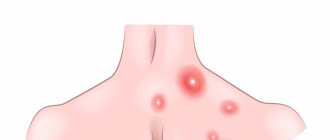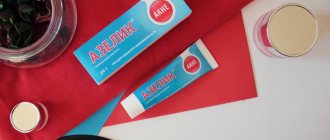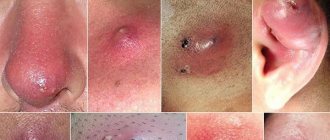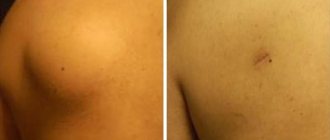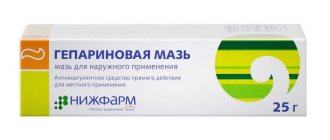Dermatovenerologist
Khasanova
Alina Rashidovna
9 years experience
Make an appointment
If staphylococcal bacteria enter the hair follicle of the skin, it can cause serious inflammation. An accumulation of pus with tissue necrosis that has captured the affected area along with the sebaceous glands and tissue is called a boil, and the disease itself is called furunculosis. Its appearance is quite painful, and its development is relatively fleeting. To avoid infection of the skin and the spread of the inflammatory process to healthy tissues, at the first signs of pathology you should seek medical help.
Causes
The inflammatory process and tissue suppuration are promoted by:
- non-compliance with personal hygiene requirements or its inadequate quality;
- constant friction of clothing on the skin;
- abrasions and injuries that provide access to the subcutaneous layer for bacteria;
- intensive work of the sebaceous and sweat glands;
- hypovitaminosis;
- metabolic disorders.
Most boils form on areas of the skin with hair follicles. They often appear on the neck, face, back of the hands, and in the lumbar region. At the initial stage, inflammation makes itself felt by the appearance of a characteristic red bump that rises above the surface of the skin. After 3-4 days, a purulent head appears. Later, the boil breaks out under the influence of an increase in the volume of purulent secretion or mechanical impact. At the site of the skin break, a core is visible - the so-called necrotic tissue. 2-3 days after the rupture, the rod, along with the remainder of the purulent contents, is rejected, and the wound begins to heal.
Are you experiencing symptoms of boils and furunculosis?
Only a doctor can accurately diagnose the disease. Don't delay your consultation - call
Rehabilitation period
After 1-2 hours the patient is discharged from the clinic. If the drainage is removed, it must be removed by a surgeon after 1-2 days. It is recommended to limit physical activity for 2-3 days after the procedure. For 2 weeks, it is necessary to go for examinations and dressings at the frequency specified by the surgeon, as well as ensure a balanced diet and proper rest. The tissues heal completely within 10-14 days.
To consult, clarify prices and remove a boil in St. Petersburg, call SM-Clinic.
Kinds
Depending on the location and development characteristics, general and local furunculosis are distinguished.
- The local type of disease occurs in a limited area of skin. Its cause is the incorrect treatment of one rash or violation of sanitary requirements in matters of skin care.
- General furunculosis covers a significant area of skin and is characterized by numerous rashes. More often it occurs against a background of weakening of the body, disturbances in the functioning of the immune system, long-term chronic diseases or during a period of remission, with anemia or disturbances in the functioning of the nervous system.
The course of furunculosis can be acute or chronic. In the first case, inflammation occurs simultaneously or with a short time interval, and the disease makes itself felt by increased body temperature, headache and a feeling of weakness. The chronic form of furunculosis develops with prolonged physical fatigue, with overheating or hypothermia of the body, as well as against a background of weakened immunity. Regardless of the type of disease, if symptoms of furunculosis appear, you should contact a dermatologist as soon as possible to clarify the causes of the boil and develop effective treatment tactics.
Factors of occurrence
The causative agent of the infection is usually a pyogenic bacterium - Staphylococcus aureus. This bacterium is present on the skin of any healthy person, and causes infection only if it reaches the deep layer of the skin (for example, through microtrauma). The development of boils is also promoted by:
- dirty skin;
- increased sweating;
- overweight;
- poor nutrition;
- hot humid climate;
- hormonal imbalances in the body;
- poor metabolism.
People with diabetes mellitus, skin diseases, and those prone to stress and depression are often at risk of developing furunculosis because they have a weakened immune system.
Treatment
The main method of treating furunculosis is the use of external topical agents that relieve inflammation and pain. The course is based on the sequential use of antibiotics, antiseptic and painkillers. If there is a possibility of developing an abscess, it is possible to surgically open the boil, extract its contents and treat the site of inflammation. It is possible to use UHF therapy, which demonstrates high efficiency at any stage of the disease.
Please note: it is strictly unacceptable to self-medicate, or try to open a boil yourself to extract its contents. In addition, it is important to change clothes and bedding more often, strictly observe personal hygiene rules, but limit exposure to raw water on the affected area.
Therapeutic measures
The treatment plan usually consists of three sequential measures. First, compresses or special dressings with Vishnevsky ointment are shown. The purpose of their purpose is the full maturation of the boil. After the rod is formed, surgery is performed. Removal of the boil is performed only after pain relief. Necrotic tissue is excised, the rod is removed and drainage is performed. The third stage is antibacterial therapy. It is prescribed both for the purpose of treatment and for the prevention of complications.
It is not recommended to treat a boil at home, as it can cause complications. The most common include sepsis, infectious organ damage, and abscess boil. These conditions can threaten the patient's life.
Prevention methods
You can reduce the risk of infection with staphylococcal bacteria and the development of furunculosis if:
- keep your body clean, take a shower regularly;
- carefully treat injuries and cuts;
- lead a healthy lifestyle;
- exercise regularly;
- diversify your diet, focusing on foods high in vitamins.
In addition, it is important to promptly treat emerging diseases of internal organs, as well as dress according to the season, avoiding overheating or hypothermia of the body.
Why are boils dangerous?
When boils are treated incorrectly, self-medication, attempts to squeeze out an abscess, or when it is injured (for example, by shaving), complications often develop. These include:
- phlegmon and soft tissue abscesses - extensive purulent lesions;
- thrombosis – blockage – of lymphatic and venous tracts;
- septic phlebitis, lymphangitis and lymphadenitis - inflammation of blood and lymphatic vessels, lymph nodes.
The entry of the pathogen into internal organs and the circulatory system sometimes results in a life-threatening condition - sepsis. When self-medicating boils on the face, the infection can enter the brain and cause meningitis.
Treatment of furunculosis at JSC "Medicine" (clinic of academician Roitberg)
Qualified therapists and dermatologists of JSC "Medicine" (clinic of academician Roitberg) in the Central Administrative District of Moscow are ready to receive and examine patients with suspected furunculosis. To confirm the diagnosis, it is recommended to undergo a comprehensive examination in your own laboratory center. Treatment is prescribed on an individual basis, and its progress and results are strictly monitored by specialists. Each client is guaranteed tactful and attentive treatment, confidentiality of personal information, as well as comfort and safety during diagnostic and treatment procedures.
How to open a boil yourself?
Dermatologists categorically do not recommend trying to cope with inflammation on your own, wanting to squeeze out the purulent contents and the core of the boil at home. This is dangerous due to secondary infection, the spread of the inflammatory process to healthy tissue, the formation of new areas of inflammation and blood poisoning. The decision to open a boil is made only by a surgeon at a specialized medical institution, and only he has the right to carry out such manipulations.
What does a boil look like?
A boil is a visible lump or red bump with a purulent head on the surface of the skin. When you touch its surface, you feel relatively severe pain, the skin around it is noticeably inflamed, and its temperature is increased. The most common places of development are the back of the head, the back of the hands, the lower back, and the face. The rash can be single or massive; its symptoms do not depend on the number of points of inflammation.
Why do boils appear?
This question can be answered accurately only after a thorough diagnosis of the boil. Among the most likely causes are infection of the hair follicle of the skin with staphylococcus bacteria against the background of vitamin deficiency, violation of personal hygiene rules, wearing too tight clothes, poor-quality antiseptic treatment of abrasions and skin injuries. The disease can also be caused by intense work of the sebaceous and sweat glands, the secretion of which is a favorable environment for bacteria.
Stages of development
At the very beginning of development, a boil can easily be confused with an ordinary pimple. However, within 3-4 days the inflammation grows, covering the surrounding tissues. Upon palpation, you can feel the tension and density of these tissues.
After a few more days, a sac with a purulent formation forms in the center of the boil, a necrotic core appears and the tissue softens.
Over time, the boil, unable to withstand a large amount of pus, opens and the pus, rejecting the necrotic core, flows out. After which the swelling gradually subsides and redness passes, and a small scar forms in the center of the former boil.
The most dangerous boils are those that arise near the lips, ears and nose. You should not try to squeeze out boils yourself, even if they have arisen in other locations. This can lead to the spread of infection, which will entail serious complications leading to the development of regional lymphadenitis, lymphangitis, and thrombophlebitis.
Sources
- Shallcross, Laura J et al. “Incidence and recurrence of boils and abscesses within the first year: a cohort study in UK primary care.” The British journal of general practice: the journal of the Royal College of General Practitioners vol. 65.639 (2015).
- Clinical protocol for diagnosis and treatment of “skin abscess, boil and carbuncle of other localizations” Expert Council of the Republican State Enterprise at the Republican Center for Healthcare Development of the Ministry of Health and Social Development of the Republic of Kazakhstan dated December 12, 2014 protocol No. 9.
- Boils and carbuncles. Mayo Clinic.
- Federal clinical guidelines for the management of patients with pyoderma. Russian Society of Dermatovenereologists and Cosmetologists, 2015.
Symptoms of the disease
The formation of a boil manifests itself as follows:
- a small raised cone-shaped nodule above the skin;
- change in skin tone over the tubercle to red-violet;
- increased pain in the inflamed area;
- swelling of surrounding tissues;
- the formation of a white dot in the center of the painful area;
- opening of an abscess;
- discharge of necrotic hair follicle and purulent masses.
To establish a diagnosis and treatment, you should contact a surgeon.
General characteristics of the disease
Furuncle is a common disease - about 17% of dermatological patients are observed with it. Currently, an intensive increase in patients with the presence of boils in the nose and nasal cavity has been recorded. This significantly increases the likelihood of developing a chronic pathology – idiopathic non-allergic rhinitis.
The disease is common among adults, but boils can also appear in children. Men are susceptible to this disease more often than women. An increase in the incidence of furunculosis is observed during periods of vitamin deficiency - in autumn and spring.
